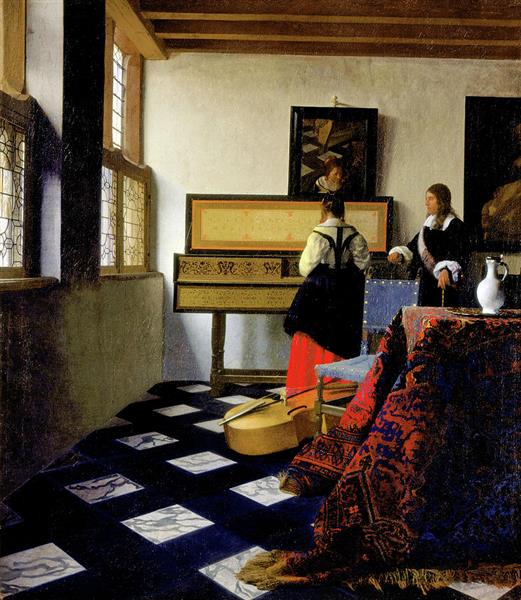The music lesson
Royal Collection (Buckingham Palace), London, UK
Johannes Vermeer, 1665
Music was an important theme in the art of Jan Vermeer, embodied in one of his well-known paintings, The music lesson. This type of scene was also painted by Vermeer’s contemporary, Frans van Mieris the Elder, a genre and portrait painter. In The Duet (1658), Mieris portrayed a damsel and gentleman making music together, while a servant brings over a drink and music book. In comparison to Mieris, Vermeer reduced the activity in the scene, but in doing so he added ambiguity to the nature of the event unfolding in the painting. Even though the title suggests that the lady playing the virginal is accompanied by her tutor, the iconography implies that the man in question could be a lover or a suitor.Music is a metaphor for harmony and love, and the type of melodies played on the virginal celebrated love and the comfort it brings. The virginal was most likely produced by the famous Antwerp instrument maker Andreas Ruckers or inspired by his craftsmanship style. In Vermeer’s time, such a virginal would have been in a wealthy household, where young ladies could practice playing the refined instrument. On the lid of the virginal Vermeer placed a Latin inscription MUSICA LETIATIAE CO[ME]S/ MEDICINA DOLOR[IS], meaning ‘Music is a companion in pleasure and a balm in sorrow’. The inscription speaks of feelings of pleasure and solace, hinting that there is a romantic connection between the two figures. Above the virginal is a mirror, which Vermeer cleverly used to reveal the young woman’s face. The reflection in the mirror corresponds with the young man’s gaze, who is attentively observing the woman playing. Vermeer also revealed his own presence by including part of his easel in the mirror reflection. By including the easel the artist reveals his position and gaze on the scene. It can be interpreted that as the man is enthralled with the woman playing, the artist is similarly absorbed in the process of painting.On the back wall there is a painting portraying Roman Charity, the story of Cimon and his daughter Pero, who managed through love and devotion to save her father from a death sentence. Pero is considered an ideal of spiritual love and Christian charity. Right under the painting, there is a white jug, which can symbolize sensual nourishment. In this way, the iconography reinforces the overall theme of spiritual and sensual love. In the foreground the artist painted another instrument, a bass viol. Through infrared technology it is known that this was a later addition to the painting since Vermeer painted it over the floor tiles and the woman’s red dress. The two instruments are another element that suggests shared pleasures and potential harmony, and as such reflect the possible relationship between the young man and woman.According to available records, the painting was initially attributed to Frans van Mieris the Elder. The misidentification was a result of a wrong reading of the signature. The painting was officially attributed to Jan Vermeer in an 1876 exhibition at the Royal Academy in London.
